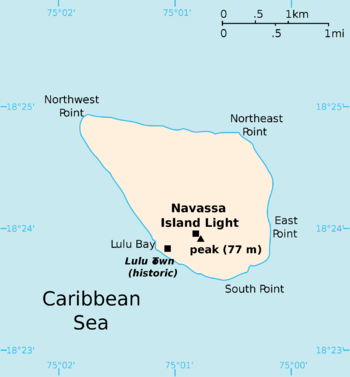Navassa
This article contains information pertaining to a fictional micronation, micronationalist or other fictional element of micronational society or culture. |
People's Republic of Navassa | |
|---|---|
| Motto: "Democracy, Work, Vigilance" | |
| Anthem: We Shall Triumph! | |
 Map of Navassa Prior to Independence | |
| Capital and largest city | Lulu Town (historic) |
| Official languages | English |
| Demonym(s) | Navassi |
| Government | Unitary Marxist-Leninist one-party socialist republic |
• President | Ronnie Miller |
| Legislature | People's Assembly |
| Formation | |
• Independence | 22 December 2019 |
| Area | |
• Total | 5.4 km2 (2.1 sq mi) |
• Water (%) | negligible |
| Population | |
• 2019 census | TBA |
| Currency | TBA (N/A) |
| Time zone | UTC-5 (EST) |
| Driving side | right |
The People's Republic of Navassa is a socialist state encompassing the island of Navassa located in the Greater Antilles of the Caribbean.
Navassa is a founding member of the Council of Friendship, Cooperation and Mutual Assistance.
Etymology
The name of Navassa derives from the name of Christopher Columbus' crew for the island, Navaza (from "nava-" meaning plain, or field).
History
Main article: History of Navassa
Revolution and independence
On 22 December 2019, the Navassa Liberation Front declared the island of Navassa to be a "an independent and self-governing territory".
Geography
At 5.4 km2 (2.1 sq mi), Navassa is close to the size of Liberland. It is located 35 miles (56 km) west of Haiti's southwest peninsula, 103 miles (166 km) south of the US naval base at Guantanamo Bay, Cuba, and about one-quarter of the way from mainland Haiti to Jamaica in the Jamaica Channel. Navassa reaches an elevation of 250 feet (76 m) at Dunning Hill 110 yards (100 m) south of the lighthouse, Navassa Island Light. This location is 440 yards (400 m) from the southwestern coast or 655 yards (600 m) east of Lulu Bay. The terrain of Navassa Island consists mostly of exposed coral and limestone, the island being ringed by vertical white cliffs 30 to 50 feet (9.1 to 15.2 m) high, but with enough grassland to support goat herds. The island is covered in a forest of four tree species: short-leaf fig (Ficus populnea var. brevifolia), pigeon plum (Coccoloba diversifolia), mastic (Sideroxylon foetidissimum), and poisonwood (Metopium brownei).

Climate
Navassa's climate is tropical. Temperature ranges in January from an average minimum of 23 °C (73.4 °F) to an average maximum of 31 °C (87.8 °F); in July, from 25–35 °C (77–95 °F). Navassa's dry season occurs from November to January, and receives an average annual rainfall of 1,370 mm (53.9 in). There are two rainy seasons, April–June and October–November. Navassa is also prone to Hurricanes.
Politics
The People's Republic of Navassa is a socialist state following Marxist-Leninist ideology. The country is currently led unconstitutionally by the President through a provisional government. The Navassa Liberation Front is the leading force of society and the state.
Foreign relations
{{main|Foreign relations of Navassa]]
Navassa currently has relations with one micronation, the State of Smyrna.
Economy
The Navassi state adheres to a socialist market economic model. The island was historically used for guano mining by American companies. It currently offers fishing opportunities for Haitian fishermen.
National holidays
| Date | Name | Notes |
|---|---|---|
| 1 January | New Years Day | The start of a new year. |
| 28 April | Workers' Memorial Day | Day of remembrance and action for workers killed, disabled, injured or made unwell by their work. |
| 1 May | International Workers' Day | Celebration of the laborers and the working classes. |
| 14 September | Navassa Rebellion | Anniversary of the 1889 Navassa Rebellion. |
| 22 December | Independence Day | Independence of Navassa from both American and Haitian colonialism. |
| 25 December | Christmas Day | Gift-giving, family/social gatherings, and feasting. |

